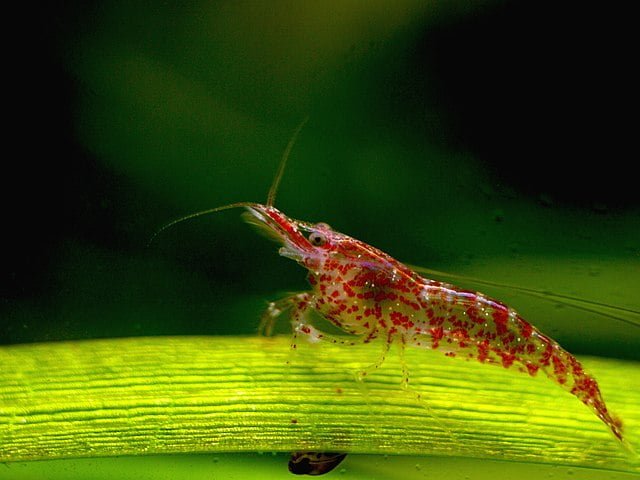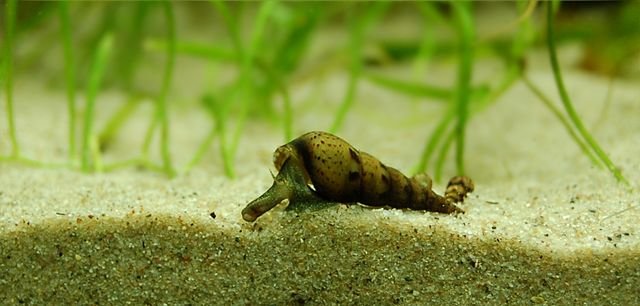Aquarium owners are familiar with freshwater snails. Some aquarists consider them a blessing because they eat algae and help clean the aquariums, but for others, they are a difficult-to-control pest.
Freshwater snails, also known as aquatic snails or river snails, are much more than simple cleaners in our aquariums. These fascinating mollusks, with their colorful and varied shells, bring life and dynamism to any aquatic ecosystem. From the small ramshorn snails to the more striking nerite snails, these invertebrates play a crucial role in maintaining the biological balance of our tanks.
These gastropod mollusks can be found in various aquatic habitats around the world. Freshwater snails live in water temperatures similar to most aquarium fish, and they are compatible with a wide variety of fish and invertebrate species.
Among aquarium enthusiasts, there is a tendency to categorize freshwater snails as “good” or “bad.” The truth is that all snails are beneficial for our aquariums as they help with cleaning by controlling algae. However, there are also species of freshwater snails that consume plants or overpopulate aquariums; these problems with snails can be avoided by getting to know them better and choosing the species that best suits your tank.
In this article, we provide an overview of the different species of freshwater snails bred in aquariums.
Freshwater Snails for Aquariums
- 1 Freshwater Snails for Aquariums
- 2 How Do Freshwater Snails Reproduce?
- 3 What Do Freshwater Snails Eat?
- 4 How Do Freshwater Snails Reproduce?
- 5 How to Care for Your Aquarium Snails
-
6
Types of Freshwater Snails for Aquariums
- 6.1 Zebra Snail – Neritina natalensis
- 6.2 Apple Snail – Pomacea canaliculata
- 6.3 Tiger Nerite Snail – Vittina semiconica
- 6.4 Assassin Snail or Carnivorous Snail – Anentome helena
- 6.5 False Planorbis – Gyraulus acronicus
- 6.6 Physa sp
- 6.7 Planorbis corneus
- 6.8 Orange Rabbit Snail – Tylomelania sp. orange
- 6.9 Trumpet Rabbit Snail – Brotia costula
- 6.10 Thai Piano Snail – Tai naticoides
- 6.11 Crowned Nerite Snail – Clithon corona
- 6.12 Yellow Rabbit Snail – Tylomelania sp. yellow
- 6.13 White Wizard Snail or Ghost Piano Snail – Filopaludina martensi
- 6.14 Giant Rabbit Snail or Devil Snail – Faunus ater cappuccino
- 6.15 Malaysian Trumpet Snail – Melanoides tuberculata
- 6.16 Mystery Snail (Pomacea bridgesii)
- 7 The Best Freshwater Snails for Aquariums
- 8 How to Eliminate Freshwater Snail Pests in Your Aquarium
- 9 Are Freshwater Snails Dangerous?
- 10 Conclusion
- 11 References
- 12 Entradas relacionadas:
According to a taxonomic review published by Strong in 2008, there are almost 4,000 species of freshwater gastropods. This diversity in size and color has made some snail species ideal for breeding in freshwater aquariums.
Ng Th et al. (2016) mention that in the ornamental pet trade, freshwater mollusks, particularly snails, have often been overlooked. Countries are implementing measures to monitor other animals for purposes of:
- Biosafety, to prevent the introduction of potentially harmful organisms, including vectors of infectious diseases; or
- Law enforcement, to protect against the illegal wildlife trade.
How Do Freshwater Snails Reproduce?
Most freshwater snails are hermaphrodites, possessing both male and female reproductive organs, allowing them to fertilize their own eggs.
Stay Always Informed
Join our communities to instantly receive the most important news, reports, and analysis from the aquaculture industry.
Most snail species produce eggs in gelatinous clusters, typically in groups of five to forty eggs. The eggs are deposited on plants, on the substrate, or float dispersed. Hatching occurs about six to eight days after being laid.
Depending on the species and environmental conditions, most freshwater snails reach maturity in four to seven weeks.
It is important to note that depending on the species, reproduction strategies will vary, as some species are hermaphroditic, while others have differentiated sexes.
Some specific reproductive traits of snails are as follows:
- Apple snails: They lay eggs above the waterline in clusters, which are easy to spot and remove if necessary to control their numbers.
- Ramshorn snails and Malaysian trumpet snails: These snails reproduce through live births or lay eggs on submerged surfaces, often hidden under leaves or rocks. If you notice an influx of baby snails, it may be time to reduce feeding and clean the substrate more thoroughly.
In the species descriptions, we provide specific reproduction details for each species of snail.
What Do Freshwater Snails Eat?
“What do aquarium snails eat?” is a common question and concern for aquatic snail breeders.
Depending on the species, freshwater snails can be omnivores or carnivores. Some freshwater snail species prefer algae and live vegetation, while others prefer organic matter, and some feed on other snails, such as Anentome helena.
Many aquatic snails live on the substrate and have a beneficial effect by removing detritus (organic remains, uneaten food, and fish waste) and aerating the gravel or sand. This helps maintain water quality in the aquarium.
Freshwater snails don’t need to be fed every day because much of their diet consists of algae. Most freshwater snail hobbyists feed them two to three times a week; however, you should ensure to remove any uneaten food after 24 hours.
The diet of snails largely depends on the species, but most snails are scavengers and eat a variety of food sources found in the tank.
- Algae: Algae are a primary food source for many snails, especially nerite snails. These snails are often introduced into tanks for their ability to clean algae from the glass and plants, making them an essential part of the tank’s cleaning crew.
- Plant debris: Many freshwater snails, such as ramshorn snails and mystery snails, consume decaying plant matter, helping keep the tank clean.
- Leftover fish food: Freshwater snails often eat any leftover food that falls to the bottom of the tank. However, overfeeding the fish can lead to a snail overpopulation due to the excess food available.
- Specialized diet: Some snails, like mystery snails, also benefit from a more varied diet, including blanched vegetables like spinach, zucchini, and cucumbers, as well as specially formulated snail food.
It is important to ensure freshwater snails have a diet rich in calcium, a mineral essential for their rapid growth and, above all, to maintain healthy shells.
How Do Freshwater Snails Reproduce?
Most freshwater snails are hermaphrodites, possessing both male and female reproductive organs, which allows them to fertilize their own eggs.
Most species of snails produce eggs in gelatinous clusters, typically in groups of five to forty eggs. The eggs are deposited on plants, on the substrate, or float dispersed. Hatching occurs about six to eight days after being laid.
Depending on the species and environmental conditions, most freshwater snail species reach maturity in four to seven weeks.
It is important to note that reproduction strategies differ depending on the species, as some are hermaphrodites while others have differentiated sexes.
Some reproductive traits of snails include:
- Apple snails: They lay eggs above the waterline in clusters, which are easy to detect and remove if necessary to control their numbers.
- Ramshorn snails and Malaysian trumpet snails: These snails reproduce through live births or lay eggs on submerged surfaces, often hidden under leaves or rocks. If you notice an influx of baby snails, it may be time to reduce feeding and clean the substrate more thoroughly.
In the descriptions of the most important species, we provide specific reproductive details for each type of snail.
How to Care for Your Aquarium Snails
Caring for freshwater snails in aquariums is relatively easy compared to many other aquatic creatures, but there are some key factors to ensure they thrive. Most freshwater snails require similar care, and therefore, the water quality parameters will be similar. These organisms tolerate nitrate levels (<20 ppm) but do not tolerate ammonia or nitrites.
Water Quality
Freshwater snails are very sensitive to poor water conditions, so it is crucial to maintain the correct water parameters. The water’s pH should be between 7.0 and 8.0 to ensure healthy shell development. Snails can suffer from shell erosion in acidic water.
The oxygen level in the water is also an important parameter. Freshwater snails can be a good indicator of low oxygen levels when they congregate at the top of the tank, signaling that they need more oxygen, in which case, you should increase aeration.
Temperature and Hardness
Most snails prefer a temperature range between 20°C and 28°C (68°F and 82°F). Water hardness is also important; soft water can cause shell degradation. If the water is too soft, consider adding calcium supplements to strengthen their shells.
Tank Mates
Peaceful community fish are the best companions for snails. Avoid adding aggressive fish like cichlids or large loaches that may see the snails as a food source. Certain species, such as assassin snails, should not be housed with other snail species, as they will prey on them.
Some popular fish species that coexist well with freshwater snails include:
- Neon Tetras
- Guppies
- Harlequin Rasboras
- Corydoras
Substrate
Snails like the Malaysian trumpet snail benefit from a sandy substrate, as they burrow into it. For other species, a normal gravel substrate is fine, but make sure it doesn’t have sharp edges that could harm their delicate bodies.
Finally, it’s important to note that freshwater snails, like other invertebrates, are sensitive to copper. Many parasite medications contain copper, and if used in the aquarium without proper care, you could end up killing your snails.
Types of Freshwater Snails for Aquariums
With over 4,000 known species of freshwater snails, it is essential to understand the different types, their care requirements, and potential hazards. Answering the question, “How to choose which freshwater snail species to have in your aquarium?” is not simple. There are many types of aquarium snails; however, you should choose the one that best fits your type of aquarium and the fish or shrimp you breed.

Zebra Snail – Neritina natalensis
Hobbyists consider it the best snail for keeping the aquarium clean, as these snails have a higher rate of algae consumption than any other snail. The freshwater zebra nerite snail stands out due to its distinctive stripes.
Another advantage of the nerite snail is that it requires brackish water for reproduction, which solves the issue of overpopulation in freshwater tanks.
Nerite snails are compatible with most plants, fish, and shrimp; however, you need to be cautious to prevent them from escaping.
- Temperature: 21 to 27°C
- GH: 5-8 dGH
- pH: 7.5-8.5
- Size: Up to 4 cm in shell size
- Diet and uses: They feed on algae and are not interested in plants, so if there are no algae in the aquarium, you should provide them with algae wafers or spirulina.
- Reproduction: Both sexes are needed for egg-laying, and brackish water is required for the eggs to develop, making their reproduction very challenging.
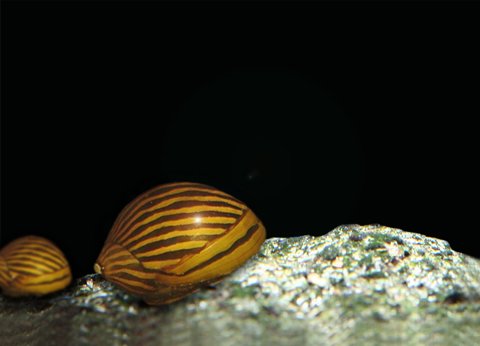
Apple Snail – Pomacea canaliculata
Apple snails are the largest aquarium snails. Pomacea canaliculata is a freshwater snail native to tropical and temperate South America (Qin et al., 2020). There are different species, all belonging to the family Ampullariidae. These snails come in a wide variety of colors, including brown, white, yellow, blue, purple, and more.
This river snail consumes leftover artificial food from your fish, along with waste and organic matter, making it an excellent “cleaner” for your aquarium.
In certain countries, like Spain (due to the invasion of rice fields in the Ebro Delta), the breeding of this freshwater snail is prohibited as it is considered a pest. However, it is also being used in animal feed and for aquaculture species (Nusantoro et al., 2024).

Tiger Nerite Snail – Vittina semiconica
The tiger nerite snail, also known as the diamond nerite, stands out for its dark amber color with small black stripes. This snail adapts very well to coexisting with plants and small fish.
Vittina semiconica feeds on algae, plant debris, and uneaten fish food.
- Temperature: 22 – 26°C
- pH: 7.5-8.5
- GH: 5-8 dGH
- KH: 5.15 dKH
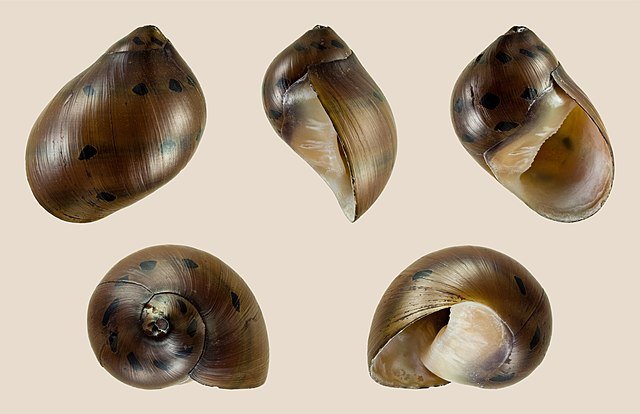
Assassin Snail or Carnivorous Snail – Anentome helena
As its name suggests, the assassin snail (Anentome helena or Clea helena) primarily feeds on other snails, which is why it is widely used to eliminate snail infestations in freshwater aquariums. These snails can reach a maximum size of 2.5 cm.
Karmakar et al., (2022) report predation by Anentome helena on freshwater snails Racesina luteola and Physella acuta when raised together in an aquarium.
The assassin snail is native to Southeast Asia and is also a scavenger, meaning it will consume leftover fish food or decaying plant matter. In aquarium shops, the river snail A. helena is one of the most in-demand species.
- Temperature: Between 22°C and 26°C
- pH: Between 7.3 and 8, with slightly hard water
- Diet and Uses: This snail mainly feeds on other snails, making it highly sought after as it is used to control unwanted snail infestations in aquariums.
- Reproduction: Assassin snails are gonochoric (having separate sexes), so if you want to breed them, it’s recommended to start with at least 5 or 6 snails to ensure you have both males and females. Reproduction is slow, as females lay only 1 to 4 eggs per clutch. The eggs are transparent and difficult to see, hatching in about 8 to 9 weeks, depending on the temperature.
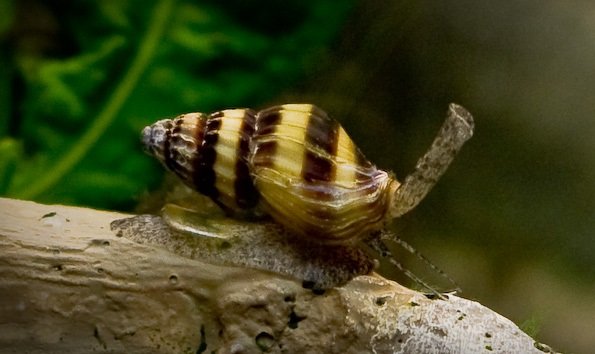
False Planorbis – Gyraulus acronicus
This species is distributed in many regions around the world; however, it is abundant in Europe and North America.
Aquariums should have plenty of natural plants, which will favor the growth and reproduction of the snail.
- Temperature: The ideal range is 25-27 ºC, although they can tolerate temperatures as low as 15 ºC and as high as 35 ºC.
- Hardness: 8 to 12 dGH
- pH: 7 or higher
- Size: 5 mm in diameter and up to 2 mm in thickness.
- Diet and Uses: Omnivorous. Their primary food source is the microscopic algae that grow on glass, plants, rocks, and substrate. They also consume detritus.
- Reproduction: Individuals are hermaphroditic, and their sexual reproduction is cross-fertilization. After mating, they deposit clusters of orange and translucent eggs on the leaves and stems of plants. The eggs hatch after more than a week.
Physa sp
- Temperature: Around 23-28 ºC.
- Hardness: Semi-hard to hard water.
- pH: 7.0-8.0
- Size: 1.5 cm long and nearly 1 cm thick.
- Diet and Uses: Generally omnivorous, feeding on decomposing plant material and encrusted algae.
- Reproduction: This snail is considered a pest, although it is very useful in aquariums, so there is obviously no issue regarding its reproduction.

Planorbis corneus
- Ideal Temperature: 20º to 26º
- pH: 7 to 8.5
- Size: Up to 20 mm
- Diet and Uses: Omnivorous and scavenger, commonly used in aquariums to remove leftover food from fish.
- Reproduction: They are hermaphroditic and deposit their eggs throughout the aquarium, hatching in 1 to 4 weeks, depending on the aquarium temperature.

Orange Rabbit Snail – Tylomelania sp. orange
The orange rabbit snail is becoming a favorite among aquarium enthusiasts due to its large size, interesting colors, and rabbit-like appearance.
Tylomelania sp. is native to Sulawesi (Indonesia), can grow up to 10 centimeters in length, and live up to 3 years.
- Ideal Temperature: 76 – 84 °F
- pH: 7.8 – 8.4
- Size: Up to 120 mm
- Diet and Uses: They feed on algae, organic matter such as dead plants, and other detritus, but can also consume uneaten fish pellets.
- Reproduction: They are gonochoric and give live birth.
Trumpet Rabbit Snail – Brotia costula
The trumpet rabbit snail is native to Southeast Asia, mainly Thailand. Brotia costula typically inhabits shallow waters near riverbanks.
- Water Temperature: 20-28 °C
- GH: 10 d
- pH: 6 to 8.5
- Diet: They accept commercial food but also tend to eat detritus and algae.
- Reproduction: They exhibit sexual dimorphism, with females being larger than males. They are viviparous, and females give birth to live young every 14 days.
Thai Piano Snail – Tai naticoides
- Temperature: Ideal at 24 °C, can range from 22 °C to 30 °C.
- pH: 6.5-8
- GH: 10 to 15º
- Size: 3-4 cm
- Diet and Uses: They primarily feed on algae and decaying plant material, although it is advisable to provide them with sinking pellets.
- Reproduction: They can breed in our aquariums and can be either males or females.
Crowned Nerite Snail – Clithon corona
- Temperature: 22 – 26 °C
- pH: 7.5 – 8.5
- GH: 5 – 8 dGH
- KH: 5 – 15 dKH
Yellow Rabbit Snail – Tylomelania sp. yellow
- Ideal Temperature: 23 – 29 °C
- pH: 7.5 – 8.5
- Hardness: 5 – 8 dGH
- KH: 5 – 15 dKH
- Size: Can reach up to 15 cm depending on the species
- Diet and Uses: They generally feed on organic and plant matter and are nocturnal.
- Reproduction: These freshwater snails can reproduce in aquariums if you have at least one male and one female. They reproduce relatively slowly, depositing eggs every 4-6 weeks.
White Wizard Snail or Ghost Piano Snail – Filopaludina martensi
The white wizard snail (Filopaludina martensi) is a species native to Thailand, although it is distributed throughout Southeast Asia.
According to experts, the white wizard snail is easy to care for and has a conical shell that is whitish in color. These freshwater snails are peaceful and quite active in their search for food (mainly algae, detritus, and periphyton).
White wizard snails exhibit sexual dimorphism, with males differentiated by one antenna having a modified shape, and females being larger than males (Sawangproh et al., 2021).
Filopaludina martensi can thrive in a wide variety of aquarium water conditions, but it’s a good idea to keep them in a typical tropical community aquarium with clear water, moderate flow, and oxygen-rich water.
- Ideal Temperature: 22° to 28°
- pH: 7 to 8.5
- GH and KH: Medium to hard.
- Size: Up to 5.5 cm
- Diet and Uses: This snail is a filter feeder, so it’s advisable to provide powdered food.
- Reproduction: They are viviparous and have differentiated sexes.
Giant Rabbit Snail or Devil Snail – Faunus ater cappuccino
The devil snail can reach between 5 to 7.6 cm in length. They are brackish water snails, so their eggs do not hatch in freshwater.
- Temperature: 22 – 26 °C
- pH: 7.0 – 8.0
- GH: 5 – 8 dGH
- KH: 5 – 15 dKH
- Diet: They feed on decaying plant material and uneaten fish food.
Malaysian Trumpet Snail – Melanoides tuberculata
This small snail is the best-known scavenger for maintaining aquariums; however, it can also be the most despised creature on earth when its population gets out of control.
Trumpet snails feed in the substrate during the day, keeping it aerated and removing organic waste. Melanoides tuberculata are excellent scavengers for planted aquariums, shrimp tanks, and aquariums that are heavily stocked or generously fed. The most important thing about these snails is that they do not eat live plants; they prefer algae, fish food residues, dead plants, and dead fish.
- Reproduction: They are parthenogenetic, meaning females can give birth to more females without contact with a male. Therefore, it is almost impossible to get rid of them once they enter your aquarium. Berry et al., (1974) reported that the number of developing young in the brood pouches of trumpet snails increases with the height of the parent snails’ shells.
One method to control freshwater trumpet snail populations is to reduce feeding and regularly siphon the substrate to deprive the trumpet snails of their food source.
The freshwater snail Melanoides tuberculata has been reported as an invasive species in the United States, Cuba, the Dominican Republic, Honduras, Panama, Puerto Rico, Argentina, Brazil, Colombia, Paraguay, Peru, and Venezuela. Therefore, it is recommended to take precautions when breeding them in aquariums.
- Ideal Temperature: 64.5° to 86 °F
- pH: 7 to 8
- Substrate: Sand.
- Size: Up to 2.54 cm
Mystery Snail (Pomacea bridgesii)
Known for its colorful shell, the mystery snail is a peaceful addition to any freshwater aquarium. It comes in various colors such as gold, blue, and ivory, adding visual interest to the tank.
The Best Freshwater Snails for Aquariums
When choosing the best freshwater snails for aquariums, it’s important to consider the tank size, the type of fish present, and the snail’s role in the ecosystem.
- Nerite Snails: Often considered the best option for algae control, they are hardy, do not breed in freshwater, and come in various attractive patterns.
- Apple Snails: Popular for their size and vibrant colors, apple snails add aesthetic value to the tank while also rummaging through waste and leftover food.
- Assassin Snails: Ideal for those battling snail pest outbreaks, assassin snails can help keep populations under control without harming other tank inhabitants.
How to Eliminate Freshwater Snail Pests in Your Aquarium
It’s not always possible to completely eradicate freshwater snail pests from an aquarium, but you can drastically reduce their numbers by doing the following:
- Regularly Vacuum the Gravel: Remove dead plant material and detritus to eliminate their food sources.
- Feed Your Fish Less: Control the amount of food and waste available for river snails by reducing the feed.
- Physically Remove Snails: Hand-pick the freshwater snails or use a snail trap with bait.
- Introduce Assassin Freshwater Snails: They will eat your aquatic snail pests.
- Use Fish That Eat Snails: Certain fish species, including loaches, catfish, cichlids, and puffers, consume aquatic snails and can effectively reduce bothersome freshwater snail populations.
- Use Freshwater Snail Killing Products: Chemicals should be your last resort and should be used with extreme caution, as they can be harmful or lethal to plants, shrimp, invertebrates, and fish.
Are Freshwater Snails Dangerous?
A common concern for new aquarium owners is whether freshwater snails pose a danger to humans or fish. For the most part, freshwater snails do not threaten your aquarium inhabitants. However, there is a notable exception: some snails may carry parasites.
Parasites
In the wild, freshwater snails can host parasites like liver flukes or schistosomes, which can cause diseases in humans, such as schistosomiasis. This disease affects over 200 million people worldwide, primarily in Africa (Brees et al., 2021). It’s important to note that how freshwater snails can harm humans is related to these parasites, not the snails themselves. This is a concern in regions with poor water sanitation but does not affect snails bred in aquariums.
Pest Snails
Pest snails, such as bladder snails and pond snails, can quickly invade a tank. While they are not dangerous, they can be a nuisance. Introduce predators like assassin snails or manage their population manually to avoid an outbreak.
Conclusion
Freshwater snails can become an aquarist’s best ally as they help clean the tank; however, you must be careful to control the population of snails in the aquarium to prevent it from getting out of hand.
Choosing the species of freshwater snail to raise in your aquarium is an important task, considering the type of ornamental fish that inhabit your tank, which must be compatible with the chosen aquatic snail species.
On the other hand, in countries like South Korea, there is commercial breeding of the freshwater snail species Pomacea canaliculata for human consumption (Ghosh et al., 2022), and the tegololo snail in Mexico. In this regard, freshwater snail aquaculture could be an important business alternative for rural communities.
References
Berry, A. J., & Kadri, H. (1974). Reproduction in the Malayan freshwater cerithiacean gastropod Melanoides tuberculata. Journal of Zoology, 172(3), 369-381. https://doi.org/10.1111/j.1469-7998.1974.tb04113.x
Brees, J., Huyse, T., Tumusiime, J., Kagoro-Rugunda, G., Namirembe, D., Mugabi, F., … & Jacobs, L. (2021). The potential of citizen-driven monitoring of freshwater snails in schistosomiasis research.
Ghosh, S.; Meyer-Rochow, V.B.; Jung, C. Farming the Edible Aquatic Snail Pomacea canaliculata as a Mini-Livestock. Fishes 2022, 7, 6. https://doi.org/10.3390/fishes7010006
Karmakar, R., P. Paul and G. Aditya: Predation and prey preference of the exotic snail Anentome helena on two freshwater snails: implications for species invasion. J. Environ. Biol., 43, 293-298 (2022).
Ng TH, Tan SK, Wong WH, Meier R, Chan S-Y, Tan HH, et al. (2016) Molluscs for Sale: Assessment of Freshwater Gastropods and Bivalves in the Ornamental Pet Trade. PLoS ONE 11(8): e0161130. https://doi.org/10.1371/journal.pone.0161130
Nusantoro, S., Natsir, M. H., & Sjofjan, O. (2024). Nutritive Value of Golden Apple Snail (Pomacea canaliculata) as Animal and Aquaculture Feed. Reviews in Agricultural Science, 12, 147-164.
Qin, Z., Yang, M., Zhang, JE. et al. Effects of salinity on survival, growth and reproduction of the invasive aquatic snail Pomacea canaliculata (Gastropoda: Ampullariidae). Hydrobiologia 847, 3103–3114 (2020). https://doi.org/10.1007/s10750-020-04320-z
Sawangproh, W., Phaenark, C., Chunchob, S., & Paejaroen, P. (2021). Sexual dimorphism and morphometric analysis of Filopaludina martensi martensi (Gastropoda: Viviparidae). Ruthenica, Russian Malacological Journal, 31(2).
Strong E. E., Gargominy O., Ponder W. F. & Bouchet P. (2008). “Global Diversity of Gastropods (Gastropoda; Mollusca) in Freshwater“. Hydrobiologia 595: 149-166. hdl.handle.net doi:10.1007/s10750-007-9012-6.
Editor at the digital magazine AquaHoy. He holds a degree in Aquaculture Biology from the National University of Santa (UNS) and a Master’s degree in Science and Innovation Management from the Polytechnic University of Valencia, with postgraduate diplomas in Business Innovation and Innovation Management. He possesses extensive experience in the aquaculture and fisheries sector, having led the Fisheries Innovation Unit of the National Program for Innovation in Fisheries and Aquaculture (PNIPA). He has served as a senior consultant in technology watch, an innovation project formulator and advisor, and a lecturer at UNS. He is a member of the Peruvian College of Biologists and was recognized by the World Aquaculture Society (WAS) in 2016 for his contribution to aquaculture.

